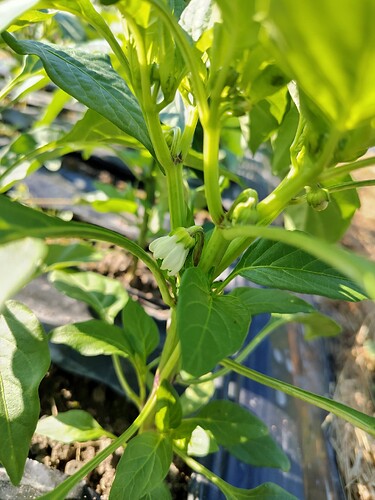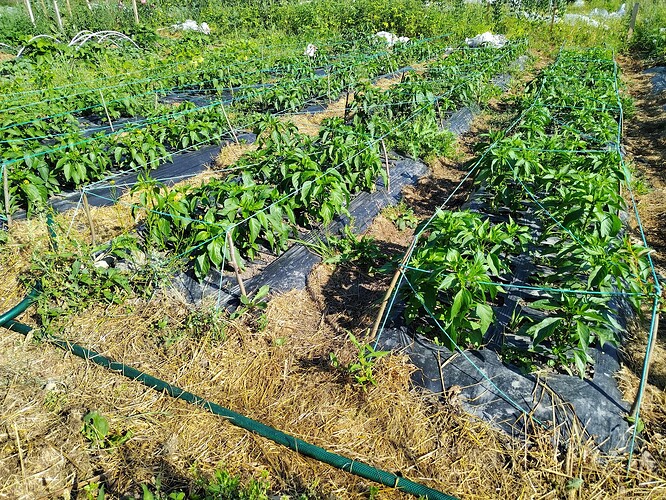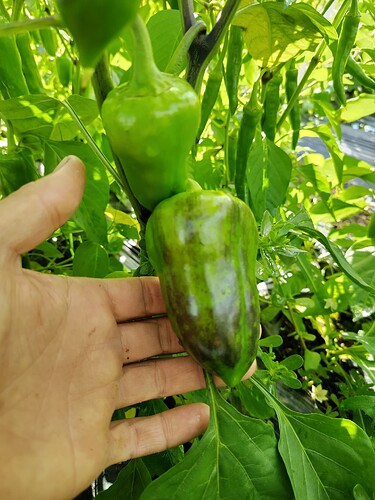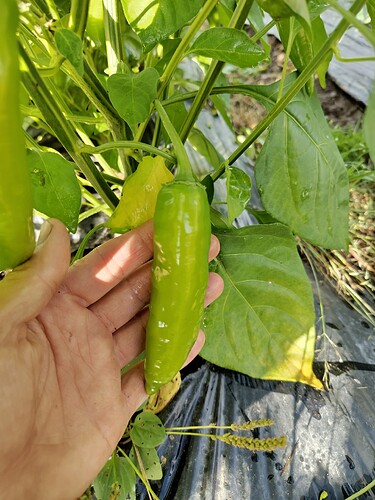Peppers for this year for sowed 21.5, almost the same date (20.5) as last year. Besides annuum I have also about 5 row meters of baccatum. I didn’t want to waste that much space before I have better idea of the feasibility. They are just that much slower that it might make the difference between getting seeds if the weather isn’t favourable. I do have some baccatum and praetermissum that I got from @polarca that I will have in pots so even in the worst case I should be able to make some crosses using the strongest plants. Of the annuum about half is from last years direct sown, quater half wilds or quater wilds and last quater is mix of F2s from last years F1 grow-out. Last summer was quite average so I’m quite confident that at least some annuums will make viable seeds this summer also, but it’s far from certain. Besides these I have also some plants from transplants and a very small trial (1-3 mature plants) of direct sowing eggplants the same way instead of using clear plastic like my main eggplant trial. This just to see how much difference it makes and if it’s viable in the future. Similarly I have a small patch of peppers with tomatoes just to see how they fare. Failures teach you much more than successes.
I’d say this has potential!
Yes, I think so too. Last year there weren’t any significant outliers, but one can hope. At least got to select the fastest of the fastest.
Both annuums and baccatums had emerged a couple of days ago. Didn’t take significantly longer than last year dispite coolish weather for them. Cloth and biofilm does help more in cool than in warm weather. Seems like baccatums don’t need any more heat to germinate compared to annuums. If anything, baccatums might have been a little better, but they were mostly one mix whereas annuums were different mixes sown different amounts. Some also probably had high amount of inviable seeds coming from last years direct sown trial. Overall looks better spread than last year and probably not going to be any larger empty stretches.
All that is encouraging. ![]()
That is my impression too as I’ve sown some of your Capsicum a while ago in an unheated greenhouse and I sow the baccatums jumping all around when the annuum were growing slowly. Now in the fields the Baccatum grow strongly as some my most vigorous physalis: the floridana and the probably-not-viscosa strains I got, which are super fast growing and luxuriant compared to the usual pruinosas (reference of the discussion relative to those physalis is here).
Just realized that it might also be similar case to eggplants. They are generally faster than peppers, but temperature evens out the differences. I still don’t think baccatums heat requirement is much more than annuums (unlike in chinense), but there still might be some once you get closer to limits. Last year baccatum transplans seemed more vigorous and had healthier looking growth, but annuums in general were faster. Partially it’s different growth habbit, annuums being bred more to produce and baccatums still closer to old “landraces”. That might be reason why they were more vigorous after transplanting; they still have good rooting genes. I suspect that part of the problem with annuums is that they are bred to be rootbound in many cases. In tomatoes it seems that there were some more vigorous rooting right in the F2 generation. Still the roots weren’t anything compared to habrochaites crosses at the end of season. Vigour from transplant was also next level. Maybe there is something like that to be found in wild chilies as well.
Also the ones I sowed as an experiment to bare ground have emerged. Quite well compared to the ones with biofilm and cloth. They took some 30-40% longer, but that should even out the later in the season we get. My experience/estimation is that black mulch and cloth both speed up the growth about a week or a little less depending on the weather, crop and how long cloth is kept on. So these could start to flower in early august. To make viable seeds with some certainty they should flower in july so it’s close, but no sigar. I can still use them to make crosses to wilds in the pots. It’s also a learning experience. Peppers I haven’t seen volunteer like other solanecea even if they could. I suppose not many fruits fall to ground as with those others.
Look at those weeds. They are still so tiny. It’s a testament to how tough the conditions have been.
I’m now starting to learn that with peppers it’s better to give small seedlings some water even if it rains some. It’s not that there isn’t moisture, but it’s a little deeper down. The row on the side seems to be the most moist, hence more weeds, but also slightly better growth on average. If my season was long enough loosing a little time early on wouldn’t matter, but with how much time/heat they currently need I can’t loose any days so I’ll have to make a routine of it in the future. Now I gave them a little water and will give every few days until they can access moisture deep down more easily.
As expected they are behind from last year, but might not be as much as I initially thought. Really hard to compare sizes at this stage. I think they are at most a week behind at this point compared to last year, but it’s likely to be a little less. Also probably not as much as days in the early season aren’t equal to late season when conditions are better for growth. Also last year I removed cloth at the end of june and I can keep it on to maybe catch up a little bit. I’m not too worried. It’s just this time of the year when everything seems to be moving so slow. Granted it’s not as warm as it could be, but with the cloth temperatures should be sufficient for not to cause major delays.
Baccatums continue to surprise. Biggest are just making their 3th true leaves and look to be a little more developed than biggest annuums. I did notice last year that baccatum transplants were much faster to recover from the planting and the reason might be that they still have better rooting. This would make sense as they have not been bred to be grown comercially in limited rooting spaces like annuums. As far as I know, most were until very recently grown by direct sowing and probably still are in their native ranges. I had them in the driest part and so there was quite a variance depending on the spot. Still they looked more advanved compared to annuums in the same and adjacent row.
Some of the best baccatum.
Made some quick selection and weeding. The situation is looking much better than it looked peeking from under the cloth. Compared to last year there seems to be more variance and more of those that have twisted growing point. I could imagine it’s due to cooler conditions. Probably some good selection pressure and made the selection easier. Still many places there are a lot of extras. Have to make a harder selection early next month. Compared to last year they are maybe little less than a week behind which is good considering the conditions, but will also put getting viable seeds right on the edge. Good thing is that if they’ll make seeds this year, they will make pretty much any year.
Before and after.
One of the best annuums.
One of the best baccatums. It seems like maybe they have developed slightly less compared to annuums. Maybe their limits aren’t as low as annuums. Should get a little warmer now to make their life a little easier.
Growth is starting to show. In the pictures 9 days of growth from best annuum, best baccatum and one piece of annuum bed. This is also after last very short heat wave in more typical to sligtly under summer temps. Today started the first extented heatwave with high of 29C/84F. At least next week should be highs around with even lows around 20C/68F, warmer than most of day highs this summer. It looks to go slowly down this coming week, but no clear sign of colder weather. Ground has good time to warm up properly and growth should pick up even more. I took of the cloth as it’s not much use in these temps. They can get more light without and hopefully something can come to eat aphids that came with few of the transplants. Not big problem yet, but it would be good if something could control them a bit.
Based on development the best still look to be about week behind last year. If so there is just enough time for some of the first to flower make viable seeds most years, but it looks to be harder selection than last year. That’s fine as not all years will be this hard and I also have some ideas to improve the system. Especially to make micro climate more fair so that there isn’t that much difference due to luck.
After some weeding and culling. Still didn’t make hard culling, but waiting more clear signs of branching out and flower development to make more accurate judgement.
After bit cooler start to the season came unusually hot and long heatwave (that is still ongoing, although looks to cool just a few degrees for now) and growth has exploded. For the last two weeks highs have been 27-31C/80-88F and lows have been similar to highs earlier this summer, between 14-20C/57-68F. First annuum opened flower today and first baccatum looks like it will open tomorrow. More annuums look to open flowers soon, but main flowering is going to be a little late. Fortunately I have some wilds of both species on pots to make crosses with. There might not be as many fully developed fruits to harvest this year, but should be still quite a bit because of the large area. Main thing is that I get seeds and/or crosses to make the project one year futher.
First peppers now about 3 weeks from flowering and biggest fruits are starting to size up. First to flower has clearly biggest fruit even thought it only has day or 2 advantage to some plants. Might be that it just makes bigger fruits than others and it’s hard to compare how developed those are or maybe it has something that makes it more suited here. Baccatums are also starting to get closer to full sized fruits. As the highs are expected to be under or around 15C/59F at least next week or so and no sign that proper summer would come back I put a cloth on until it’s time to harvest them. Hopefully temps remain high enough untill mid september and it’s dry enough. In september it can easily get too humid and peppers start to rot. Cloth doesn’t help the matter, that’s why I put it on now when days are still longer and sun can have some effect.
Peppers harvested about 2 weeks ago before the first hard frist. First harvest is those that were most likely to make it to seed saving. Later I also harvested about same amount. Overall it was quite a success considering the early season weather. First only started to ripen a couple days after being brought indoors and the difference in the amount of fruits that fully ripened shortly after is striking compared to last year. One week does make a huge difference here. It might be for the better as now I don’t have the urge to save too much seeds. I still will have thousands or even past ten thousand, but not amount that I can’t use by oversowing the way I have. I selected some plants based on earliness and yield potential that I will grow from transplant (as well as direct sow) to make better judgement on their yield. Otherwise all will be direct sown next year as well and have to make to top of the top to make it. I did make some random crosses to wilds with all first to flower, although not all of those worked. Besides that, I also randomly pollinated all first flowers with others to increase diversity.
Half wilds weren’t as small as could be expected and it seems larger fruit size was favoured even with early culling. Must be something in growth that correlated with fruit size. Not that they are huge, but most of the smaller seem to have been eliminated and there are some fruits that are bigger than the ones in F1. 1/4 wild are ofcourse even bigger with some quite normal big pepper sized, but variance is bigger as well. Similarly not really small ones, but lots of medium sized. I didn’t make any selection based on size at this stage (as the very smallest were just about eliminated), except that will save seeds separately from the biggest half wild if it looks to have viable seeds.
Baccatums did also well, although this style doesn’t really work in getting yield from baccatum. They are generally just so light that 5-10 full sized fruits isn’t going to be much weight. They made fruits ripe enough to make seeds. I also made some crosses using them as pollinators. Next year will direct sow as well and make more crosses, both to wild and interspecific with praetermissum and chacoense.
First to flower and quite heavy yielder, but seems like so many that have white unripe fruits that they spoil easily. Still got saved to premium and used in crosses, but eventually if fruits spoil like that the plants will be eliminated from seed pool.
Biggest fruit in half wilds.
Some baccatum.
































